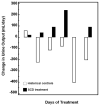Cell-based strategies for the treatment of kidney dysfunction: a review
- PMID: 23095410
- PMCID: PMC3836365
- DOI: 10.1159/000341649
Cell-based strategies for the treatment of kidney dysfunction: a review
Abstract
Conventional treatment of acute and chronic renal diseases has focused on solute removal. Novel strategies aim to treat the multifactorial disease states of acute kidney injury and chronic kidney disease by mitigating inflammation. Cell-based technologies for the treatment of kidney dysfunction fall under two broad categories: cell therapy and cell processing. Cell therapy utilizes cells that are isolated, cultured outside of the body, and reintroduced as therapy, leveraging beneficial metabolic and synthetic functions. For example, renal tubule cells have been used to provide gluconeogenesis, ammoniagenesis, metabolism of glutathione, catabolism of important peptide hormones, growth factors, and cytokines critical to multiorgan homeostasis and immunomodulation to treat renal dysfunction. Cell processing focuses on altering the characteristics of cell populations inside the body to provide therapy. The selective cytopheretic device is an example of this novel therapeutic strategy that aims to modulate the innate immune response during organ dysfunction, additional organ injury, by binding and deactivating leukocytes. In this review, both cell therapy and cell processing approaches will be discussed in the context of acute kidney injury and chronic renal disease.
Copyright © 2012 S. Karger AG, Basel.
Figures



References
-
- Nigam S, Lieberthal W. Acute renal failure. III. The role of growth factors in the process of renal regeneration and repair. Am J Physiol Renal Physiol. 2000;279(1):F3–F11. - PubMed
-
- Thadhani R, Pascual M, Bonventre JV. Acute renal failure. N Engl J Med. 1996;334(22):1448–60. - PubMed
-
- Lieberthal W, Nigam SK. Acute renal failure. II. Experimental models of acute renal failure: imperfect but indispensable. Am J Physiol Renal Physiol. 2000;278(1):F1–F12. - PubMed
-
- Lieberthal W, Nigam SK. Acute renal failure. I. Relative importance of proximal vs. distal tubular injury. Am J Physiol. 1998;275(5 Pt 2):F623–31. - PubMed
-
- Breen D, Bihari D. Acute renal failure as a part of multiple organ failure: the slippery slope of critical illness. Kidney Int Suppl. 1998;66:S25–33. - PubMed
Publication types
MeSH terms
Grants and funding
LinkOut - more resources
Full Text Sources
Medical

